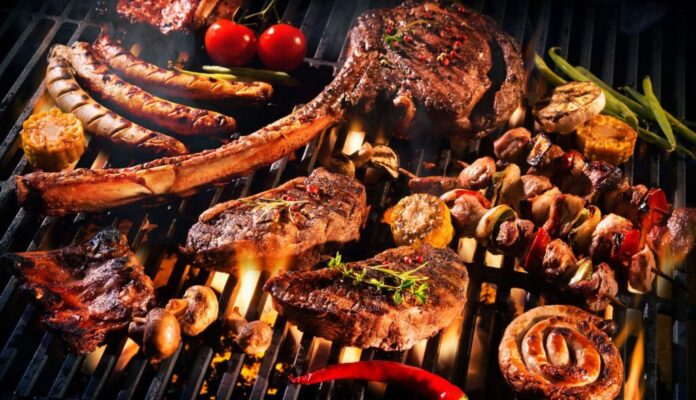Introduction:
Choosing the perfect cuts of meat for grilling is essential for achieving that mouthwatering, delicious flavor and tender texture that grilling is known for. The right cut can make all the difference between a successful cookout and a disappointing one. In this comprehensive guide, we’ll explore the factors to consider when selecting meat for grilling, the various cuts of meat available, and some expert tips to ensure your grilling endeavors are a culinary success.
Factors to Consider When Choosing Meat for Grilling
- Cut of Meat: Different cuts of meat have varying levels of tenderness and flavor. Knowing the distinctions between cuts is crucial. Consider the following factors:
- Muscle Usage: Muscles that are used less often tend to be more tender. For instance, the ribeye comes from a less-exercised part of the cow, making it tender and flavorful.
- Marbling: Marbling refers to the intramuscular fat within the meat. More marbling often results in juicier and more flavorful meat. Look for marbling in cuts like ribeye and New York strip.
- Thickness: The thickness of the meat influences cooking time. Thicker cuts take longer to cook, giving you more control over the doneness.
- Budget: High-quality cuts like ribeye or filet mignon can be expensive. Consider your budget when choosing meat.
- Grill Type: The type of grill you’re using (charcoal, gas, or wood pellet) can affect your choice of meat and cooking technique.
- Personal Preferences: Your personal taste plays a significant role. Some people prefer leaner cuts, while others enjoy fattier cuts with more flavor.
- Marinades and Rubs: If you plan to use marinades or rubs, certain cuts may be more receptive to these flavorings. For instance, boneless, skinless chicken breasts readily absorb marinades.
- Guest Preferences: If you’re grilling for a group, consider your guests’ preferences. Some may prefer well-done, while others like their meat rare or medium-rare.
Popular Cuts of Meat for Grilling
- Ribeye: Ribeye is celebrated for its rich marbling and intense flavor. It’s best cooked to medium-rare or medium for optimal tenderness.
- New York Strip: Also known as a strip steak, this cut is leaner than ribeye but still boasts excellent flavor. Grill it to medium for a balance of tenderness and taste.
- Filet Mignon: This is one of the most tender cuts available, with minimal marbling. It’s often cooked to medium-rare to preserve its tenderness.
- T-Bone: A T-bone steak features both the tenderloin (filet mignon) and the strip steak on either side of the T-shaped bone. It’s a versatile and flavorful choice.
- Sirloin: Sirloin steak is leaner and less expensive than other cuts, making it a good budget-friendly option. Grill it to medium-rare for the best results.
- Skirt Steak: This thin, long cut is ideal for marinating and grilling quickly at high heat. It’s perfect for dishes like fajitas.
- Flank Steak: Flank steak is another excellent choice for marinating. It’s best when grilled to medium-rare and sliced thinly against the grain.
- Boneless, Skinless Chicken Breasts: Chicken breasts cook relatively quickly and are versatile when it comes to marinades and seasonings.
- Pork Chops: Pork chops, particularly bone-in cuts, are great for grilling. Cook them to an internal temperature of 145°F (63°C) for optimal safety and juiciness.
- Lamb Chops: Lamb chops are flavorful and tender when cooked to medium-rare or medium. They are perfect for those who enjoy a different taste profile.
Expert Tips for Grilling Meat
- Preheat Your Grill: Ensure your grill is preheated before cooking. This helps sear the meat and lock in juices.
- Seasoning: Use simple seasonings like salt, pepper, and olive oil to let the natural flavor of the meat shine through.
- Oil the Grates: Before placing the meat on the grill, brush the grates with oil to prevent sticking.
- Use a Meat Thermometer: Invest in a good meat thermometer to ensure your meat is cooked to the desired level of doneness.
- Let Meat Rest: After grilling, let your meat rest for a few minutes before slicing. This allows the juices to redistribute, resulting in a juicier cut.
- Experiment with Marinades: Marinades can enhance the flavor of your meat. Experiment with various combinations of herbs, spices, acids, and oils.
- Grill Veggies: Complement your meat with grilled vegetables for a balanced and flavorful meal.
- Practice Safe Grilling: Ensure your meat is cooked to a safe temperature to prevent foodborne illnesses.
- Keep it Simple: Sometimes, the best grilling is done with minimal intervention. Let the quality of the meat shine through.
- Learn from Experience: Grilling is a skill that improves with practice. Don’t be discouraged by initial mishaps; each attempt is a learning opportunity.
In conclusion, choosing the perfect cuts of meat for grilling is a delightful journey of exploring flavors and textures. Understand the cut, consider your preferences, and follow expert tips to elevate your grilling game. Whether it’s a juicy ribeye, a flavorful New York strip, or a succulent chicken breast, your grill will become a canvas for culinary creativity and unforgettable dining experiences. Enjoy your grilling adventures, and savor every delicious bite.













































